MXA RACE TEST: THE REAL TEST OF THE 2022 KTM 250SX TWO-STROKE
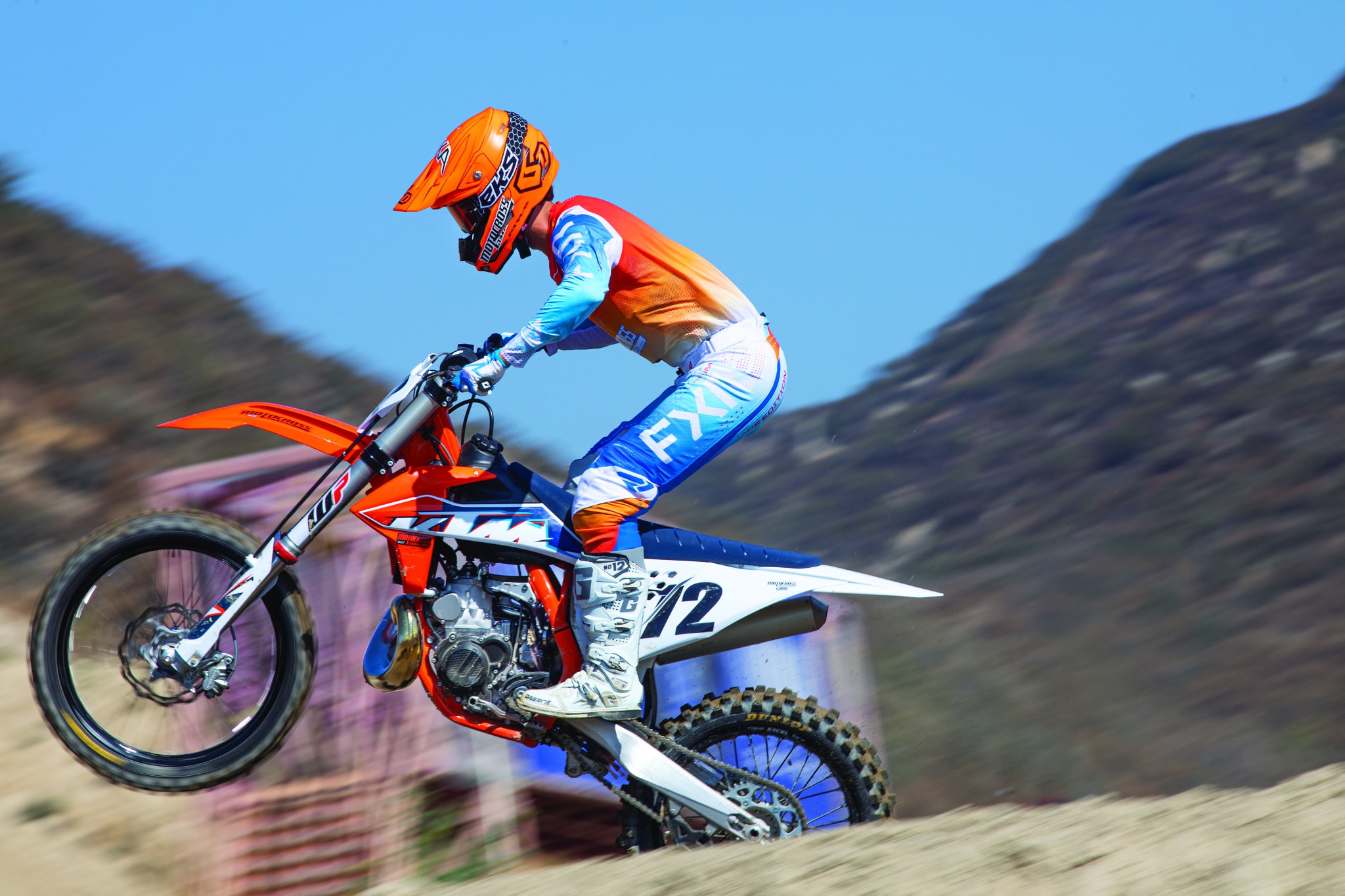 THE GEAR: Jersey: FXR Racing Helium, Pants: FXR Racing Helium, Helmet: 6D ATR-2, Goggles: EKS Brand Lucid, Boots: Gaerne SG12.
THE GEAR: Jersey: FXR Racing Helium, Pants: FXR Racing Helium, Helmet: 6D ATR-2, Goggles: EKS Brand Lucid, Boots: Gaerne SG12.
Q: FIRST AND FOREMOST, IS THE 2022 250SX BETTER THAN THE 2021 250SX?
A: Well, if you factor in the physiological effect of the “look good, feel good, ride good” philosophy, then maybe the 2022 is better than the 2021; however, the KTM 250SX didn’t gain any mechanical advantages over the 2021 version—only aesthetic ones. They replaced the black frame with the orange frame, so now the bike matches the rest of the 2022 KTM big-bike lineup (as always seems to happen the year before a big model change). On the BNG front, the 2022 graphics were updated and the seat cover is now blue.
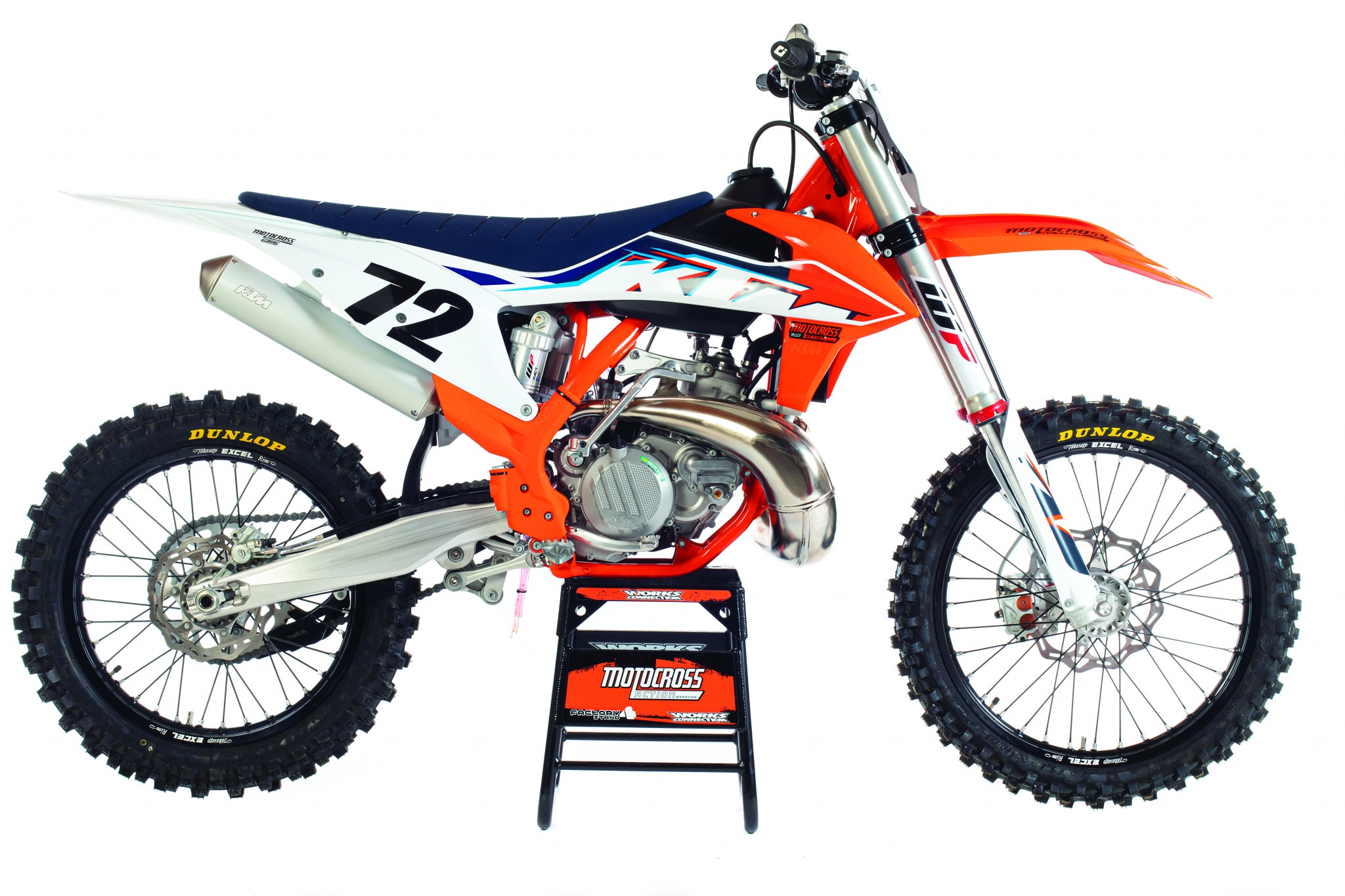 The 2022 KTM 250SX only received aesthetic upgrades like the orange frame, blue seat and new graphics.
The 2022 KTM 250SX only received aesthetic upgrades like the orange frame, blue seat and new graphics.
Q: WAS THE KTM 250SX UPDATED IN 2021?
A: Yes. Last year the 250SX gained the new WP XACT air forks that the rest of the KTM models got; however, if you’ve read our tests on other KTM two-strokes and cross-country models from 2021–2022, you know that the forks on these bikes were improved one step further than the motocross-specific four-stroke forks.
(1) Fork updates. Last year the 250SX received all-new internals with improved oil bypass notches, a new air seal with four air bypass holes and an enlarged cross-over bleed slot to help air move from the positive to the negative air chambers easier. They also added a new rubber bump-stop for bottoming control and an adjust-by-hand rebound clicker to match the top-mounted compression clicker; however, the biggest update to the two-stroke and off-road XACT air forks is the new “float setting component” in the mid-valve, but more on that later in this test.
(2) Throttle. The KTM 250SX has an updated Gunnar Gasser-style roller-actuated throttle to extend the cable life. The roller is meant to promote a smooth and durable throttle action; it doesn’t change how the throttle feels. It is called a Gunnar Gasser throttle after former Husqvarna factory racer Gunnar Lindstrom, who invented the first-ever throttle that routed the cable via roller.
(3) Airbox. The KTM 250SX now comes with an optional vented airbox cover to supply more air to the engine. The only time we don’t like it is when we’re washing the bike.
Q: HOW DOES THE 250SX RUN ON THE TRACK?
A: The bigwigs at KTM are competitive, as is demonstrated by the fact that they are dedicated to building two-strokes, even though three of their major four-stroke competitors (Honda, Kawasaki and Suzuki) stopped making smokers a long time ago. The KTM 250SX is fast on the track, and it revs through its rpm range very quickly, requiring your left foot to work overtime grabbing gears. Overall, the 250SX is more difficult to ride than its sole Japanese competitor, the Yamaha YZ250. How come? The 49.23 horsepower KTM 250SX is 3 horsepower more powerful than the YZ250. Plus, the KTM power comes on much stronger and sooner than the YZ250’s power—accordingly, it also signs off sooner.
Comparing the KTM 250SX and Yamaha YZ250 engines is like comparing a modified YZ250 to a stock YZ250. Typically, a modified YZ250 is harder to ride because the tuner will raise the exhaust ports and increase the compression to boost peak horsepower. The side effect of raising the ports is that it trades away bottom-end power for more on top. Modified YZ250 engines require more skill to ride than the stockers. As an example, for the majority of riders, the KTM 125SX is easier to ride than the KTM 150SX. But, an experienced racer will still prefer a 150 because it hits harder and fills in the midrange.
Q: HAS KTM DONE ANYTHING TO MAKE THE 250SX EASIER TO RIDE?
A: KTM has made small changes over the years to make the 250SX more user-friendly, but they haven’t changed their engine philosophy to mimic the smooth and linear power of the YZ250. How come? KTM is totally focused on building high-end race bikes that you can pick up from your local dealership and take straight to the races, while Yamaha has cast a wider net over trail riders, play riders and budget racers. To that end, Yamaha’s YZ250 engine is smooth and gentle. The YZ250 needs some upgrades to be competitive with a stock KTM 250SX.
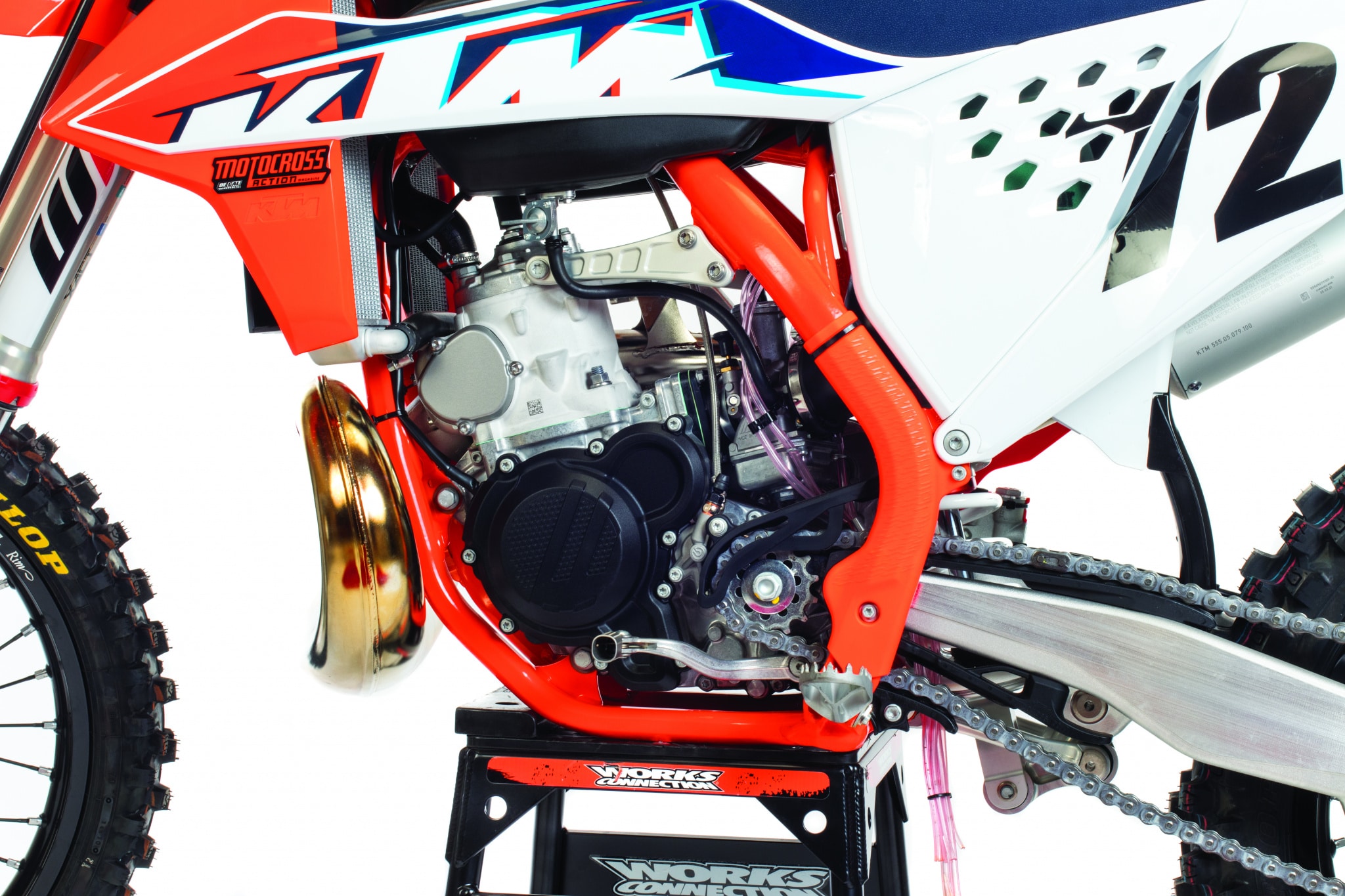 Producing 49.23 horsepower, the KTM 250SX engine is aggressive.
Producing 49.23 horsepower, the KTM 250SX engine is aggressive.
Q: HOW CAN YOU MELLOW OUT THE 2022 KTM 250SX POWER?
A: There are three unique ways KTM allows you to tune the power characteristics externally.
(1) Mapping. Most KTM 250SX riders don’t know it because there is no visible map switch, but the KTM 250SX comes with two map selections—stock and mellow. There’s a wire located under the left side of the fuel tank that has a white male/female plastic connector, and since it is the only white connector under the frame, it’s easy to spot. The stock map is dubbed the “performance” map. It comes from the factory plugged in and ready to go. MXA test riders traditionally stick to the stock map, but test riders who are looking for a smoother, less aggressive style of power delivery have been known to reach under the tank and unplug this connector to access the mellow map.
(2) Power valve. The KTM/Husky/GasGas two-strokes feature an externally adjustable power valve. The power valve plays a huge role in the character of the engine because it controls the opening of the exhaust port to expel the burnt air and fuel from the combustion chamber. A slow opening power valve mellows out the power band and slows the engine’s progress through the rpm range, creating slightly more torque and lengthening the power band. A fast-opening power valve gets into the meat of the power more aggressively and creates instant throttle response.
(3) Airbox cover. The MXA wrecking crew prefers to run the optional vented airbox cover that comes with the bike; however, if you want to detune the power, using the standard airbox cover without the vents will mute the throttle response and rein in the power a bit off the bottom.
Q: WHAT’S THE BEST POWER VALVE SETTING?
A: You need a Robertson wrench to adjust the brass power-valve screw, but this tool is hard to find in the pits. We always replace the stock brass fitting with Kreft Moto’s Powerdial 3.0. The Powerdial 3.0 allows riders to adjust the power valve by hand. Most MXA test riders start by backing the power-valve adjuster all the way out, then turning it in 1-1/2 turns. This setting is snappy off the bottom but not so aggressive that it’s difficult to handle. To further customize the power characteristics, you can change the small auxiliary spring found inside of the main power valve spring. Basically, the primary power valve spring determines at which rpm the valve opens, while the auxiliary spring determines how fast it opens once it gets there. KTM provides three auxiliary power valve spring options when you buy the 250SX: the yellow spring is stock; the red spring opens the valve to open quicker; and the green spring makes it open slower.
 The WP XACT air forks were new in 2021, and they’re greatly improved over the 2020 forks.
The WP XACT air forks were new in 2021, and they’re greatly improved over the 2020 forks.
Q: HOW ARE THE WP XACT AIR FORKS ON THE 250SX?
A: We doubt that you’ve read many other media outlets who say they “love” the new WP XACT air forks, but MXA spends more time testing them. In fact, to test their worthiness, MXA raced the 2021 World Two-Stroke Championship and the 2021 Hangtown National on stock KTM suspension. The late-model WP XACT air forks look the same on the outside as the older models but have received major internal updates that improved these forks immensely over the 2020–2021 season’s forks. Here are two reasons why they’re better.
(1) Bypass. Early iterations of WP’s air forks were notorious for being harsh in the mid-stroke and difficult to set up. Not so with the modern WP XACT air forks. The “air bypass holes” and “oil bleed notches” are the saving graces of the 2021 WP forks. Instead of the air pressure ramping up and creating harsh pressure spikes as the fork compresses deeper into its stroke, WP bleeds off excess oil and air pressure inside the fork legs, creating a plush and predictable fork action that inspires confidence in MXA test riders.
(2) Float valve. Second, we learned something big when testing the 2021 Husky TC250 last year—the 2020 and prior-model two-strokes (and cross-country four-strokes) didn’t have any valving shims in the mid-valve. They were removed, and the valving duties were shifted to the base valve. Why make such a dramatic reversal in fork valving knowhow? The WP technicians couldn’t create a setting soft enough for these bikes without breaking or bending the mid-valve shims.
(3) Trampoline shim. Thanks to the success of the four-stroke fork’s “trampoline shim,” which bowed into a cavity under the mid-valve to relieve pressure spikes late in the stroke, WP devised a float valve system to allow the use of thinner shims by installing a small spring under the bottom shim of the mid-valve stack to enable the thin shims to withstand the rigors of motocross without bending or breaking. Now, the stock KTM two-stroke and off-road air forks have valving at the mid-valve just like the four-strokes, but with the “float valve” instead of the “trampoline shim.”
Q: HOW DOES THE 2022 KTM 250SX HANDLE?
A: With its snappy engine, plush suspension and light overall weight, the KTM 250 two-stroke is a blast to ride. It is pure two-stroke—not detuned to satisfy casual riders. If you don’t have previous two-stroke experience, your first lap on a KTM 250SX will be an eye-opener. It wheelies, spins, slides and takes your breath away until you learn the proper two-stroke secrets. When it came time for MXA to set up the KTM 250SX, we didn’t stray far from the stock recommended settings, only going slightly softer on the air pressure in the forks. At 210 pounds, the 250SX is nimble and easy to move around once you learn how to use the powerband. Some bikes need more attention in the power department and others in the handling department. We spent the majority of our time playing with the power characteristics and left the suspension fairly close to stock.
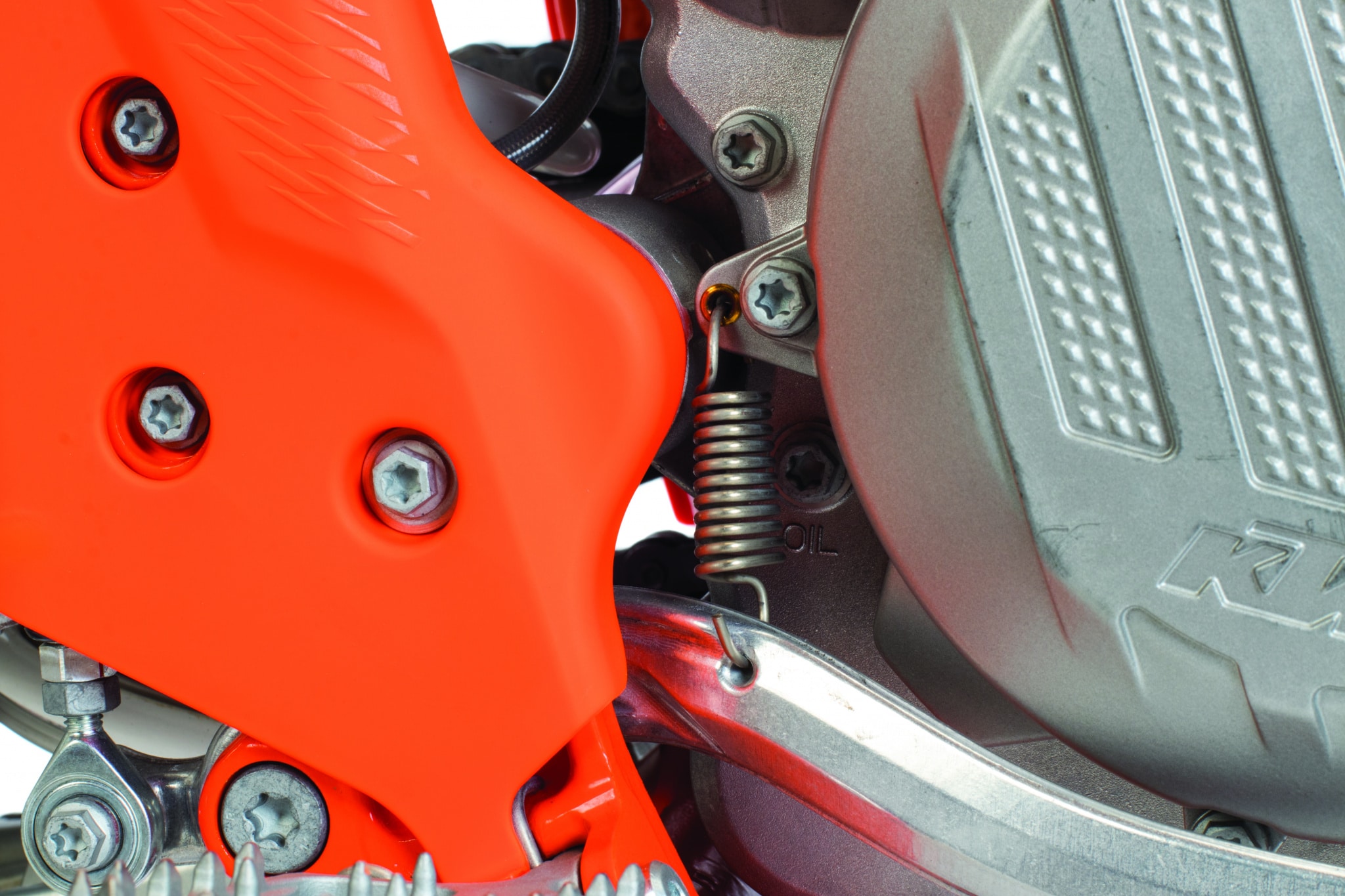 The rear brake spring often falls out or breaks. We always turn ours around so our foot doesn’t push it out of the hole.
The rear brake spring often falls out or breaks. We always turn ours around so our foot doesn’t push it out of the hole.
Q: WHAT DID WE HATE?
A: The hate list:
(1) Spokes. As always, the spoke next to the rim lock comes loose quickly, especially when breaking your bike in. Check all the spokes each time you ride.
(2) Brake-pedal spring. The spring that provides tension on the brake pedal is prone to falling off or breaking at the least opportune time. MXA always turns the spring around so that the tang closest to the rider’s foot doesn’t stick out where the rider’s boot can disengage it from the brake pedal. Make sure the bottom tang is aimed inward. If it does break, replace it with a Honda rear brake spring. They’re stronger and come with a rubber grommet around them for protection.
(3) Engine. We want to have our cake and it eat it too. We want the KTM engineers to increase top-end power and add more over-rev. It signs off too soon—way too soon.
(4) Fork break-in. If you roll a brand-new KTM off the showroom floor and take it to the track, you will hate the suspension. The forks require several hours of ride time to break through the stiction of new seals and bushings and close tolerances. They are harsh when new but plush and smooth after break-in. Always bleed excess air pressure out of the bleed screw on both legs at regular intervals.
(5) Oil change. The 250SX doesn’t have the same sight glass as the four-stroke KTMs for checking engine oil height. Instead, you have to remove the rear brake spring and back the 8mm bolt out of the weep hole to check the oil height. If a small amount of oil drips, you’re good, but this system is prehistoric.
(6) Price. The 250SX goes for $8499, which is $100 more than last year. It’s $1800 less than a KTM 450SXF four-stroke, $700 more than the Yamaha YZ250, $600 more than the all-new 2022 GasGas MC 250 and $100 less than the Husky TC250; however, without any updates to the 250SX for 2022, we can only assume this higher price tag comes from COVID-19 supply issues.
Q: WHAT DID WE LIKE?
A: The like list:
(1) Weight. At 210 pounds, everything about the 250SX is light.
(2) Suspension. The WP XACT air forks aren’t your grandfather’s air forks. They are next-level fork tech, which is why many Japanese factory teams went back to air forks on the sly. We love the plush forks and the well spec’d shock
(3) Clickers. It’s nice to be able to turn the fork’s compression and rebound clickers without grabbing a screwdriver.
(4) Gearing. MXA asked for the 14/49 gear ratio in 2019, and thankfully it has come stock since then.
(5) Brakes. The Brembo brakes feel even better when a bike is so ridiculously light.
(6) Aesthetics. The orange frame adds pizzazz to the 2022 KTM 250SX.
(7) Power valve. We appreciate an adjuster that allows us to customize the 250SX power for each rider and track.
(8) Air filter. KTM’s plug-in air-filter cage makes changing an air filter easy enough that you have no excuse not to do it.
(9) Braided steel hoses. KTM, Husky and GasGas come with braided-steel hydraulic brake/clutch hoses that don’t swell under high pressure.
Q: WHAT DID WE REALLY THINK?
A: Our Pro-level test riders can take the 2022 KTM 250SX to the races without making any upgrades and immediately be competitive. We’ve tried this on YZ250s and were less successful. If you’re looking for something that’s easy to ride, go with the YZ250. If you’re looking for a bike that is ready to race and has options that enable you to tailor it to your style, the KTM 250SX has your name on it.
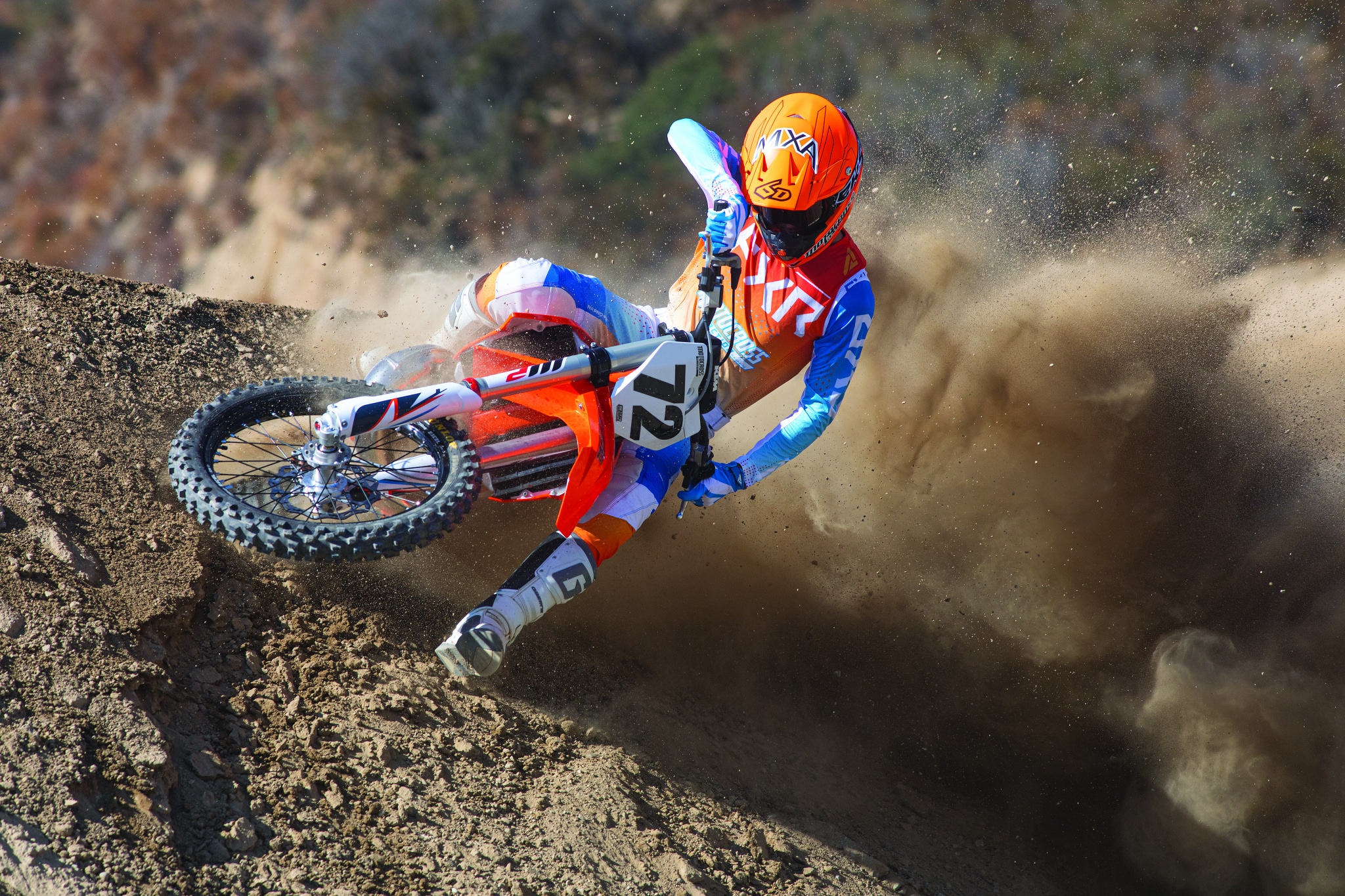 At only 210 pounds the 250SX is nimble on the track.
At only 210 pounds the 250SX is nimble on the track.
MXA’S 2022 KTM 250SX SETUP SPECS
This is how we set up our 2022 KTM 250SX for racing. We offer it as a guide to help you find your own sweet spot.
MXA’S 2022 KTM 250SX AIR FORK SETTINGS
We always recommend using a zip-tie to find the correct air pressure settings for your speed and weight. Once you find the optimum air pressure number that brings your forks to within 1-1/2 inches of bottoming, start messing with the compression clicker until you’re comfortable. Don’t expect fork nirvana until after the forks break in. For hardcore racing, we recommend this fork setup for the 2022 KTM 250SX.
Air pressure: 10.2 bar/148 psi (10.4/151 psi bar)
Compression: 12 clicks out (for Intermediate and up), 16 clicks out (for slower or lighter riders)
Rebound: 12 clicks out (16 clicks out for slower or lighter riders)
Fork height: 2nd line
Notes: As a rule of thumb, don’t start playing with your air pressure or clicker settings until you set the sag for your weight, check the tire pressure and bleed the air out of the little Torx head screws on both forks. Also, on a hot day, your fork pressure will increase over time. Check the pressure periodically throughout the day, especially if it’s hot out. We’re confident that you’ll love the new WP XACT suspension if you find your personal air pressure.
MXA’S 2022 KTM 250SX SHOCK SETTINGS
The WP XACT rear shock is easy to feel comfortable on. For hardcore racing, we recommend this shock setup for the 2022 KTM 250SX (stock specs are in parentheses):
Spring rate: 42 N/mm
Race sag: 105mm
Hi-compression: 1-1/2 turns out (2 turns out)
Lo-compression: 15 clicks out
Rebound: 15 clicks out
Notes: Our test riders turned the high-speed compression adjuster in a half-turn to increase hold up at the rear while in motion.
MXA’S 2022 KTM 250SX JETTING SPECS
The stock KTM 250SX jetting worked great for us. Obviously, there will be some air screw, needle or pilot adjustments needed for your local elevation, humidity and temperature. Here’s what we ran in our Mikuni TMX 38 carb:
Main jet: 450
Pilot: 35
Needle: 6BFY42-71
Clip: 3rd
Air screw: 1-1/2 turns out
Notes: If the bike is hesitant off the bottom end, try adjusting the air screw. Have someone hold the throttle at 1800 rpm while you turn the air screw in and out. When the engine’s idle reaches its highest peak rpm, that is where the air screw should be. Additionally, KTM recommends a 60:1 pre-mix ratio, but we run our regular 40:1 oil gas mixture and fine-tune for temperature, elevation and humidity.


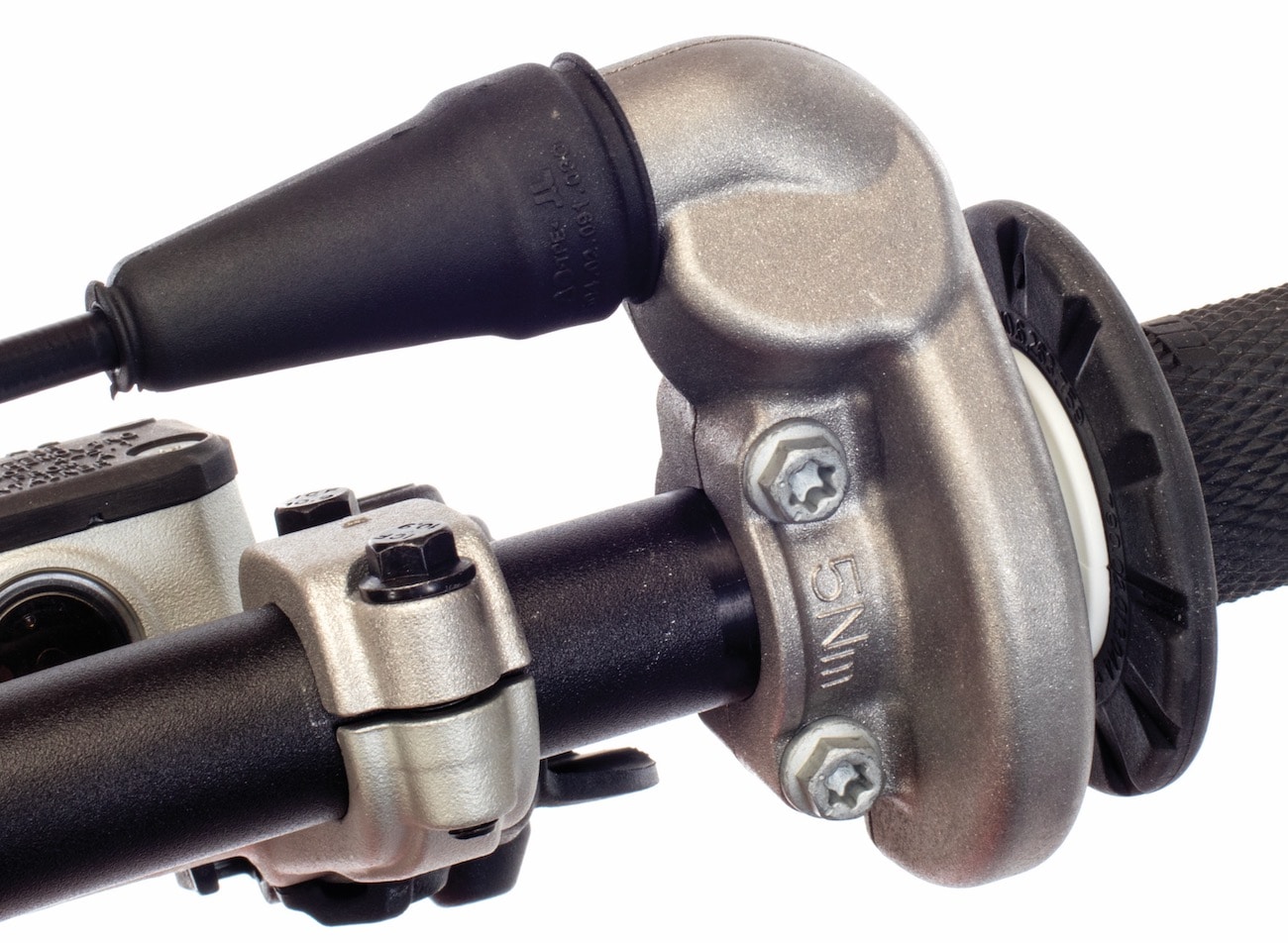
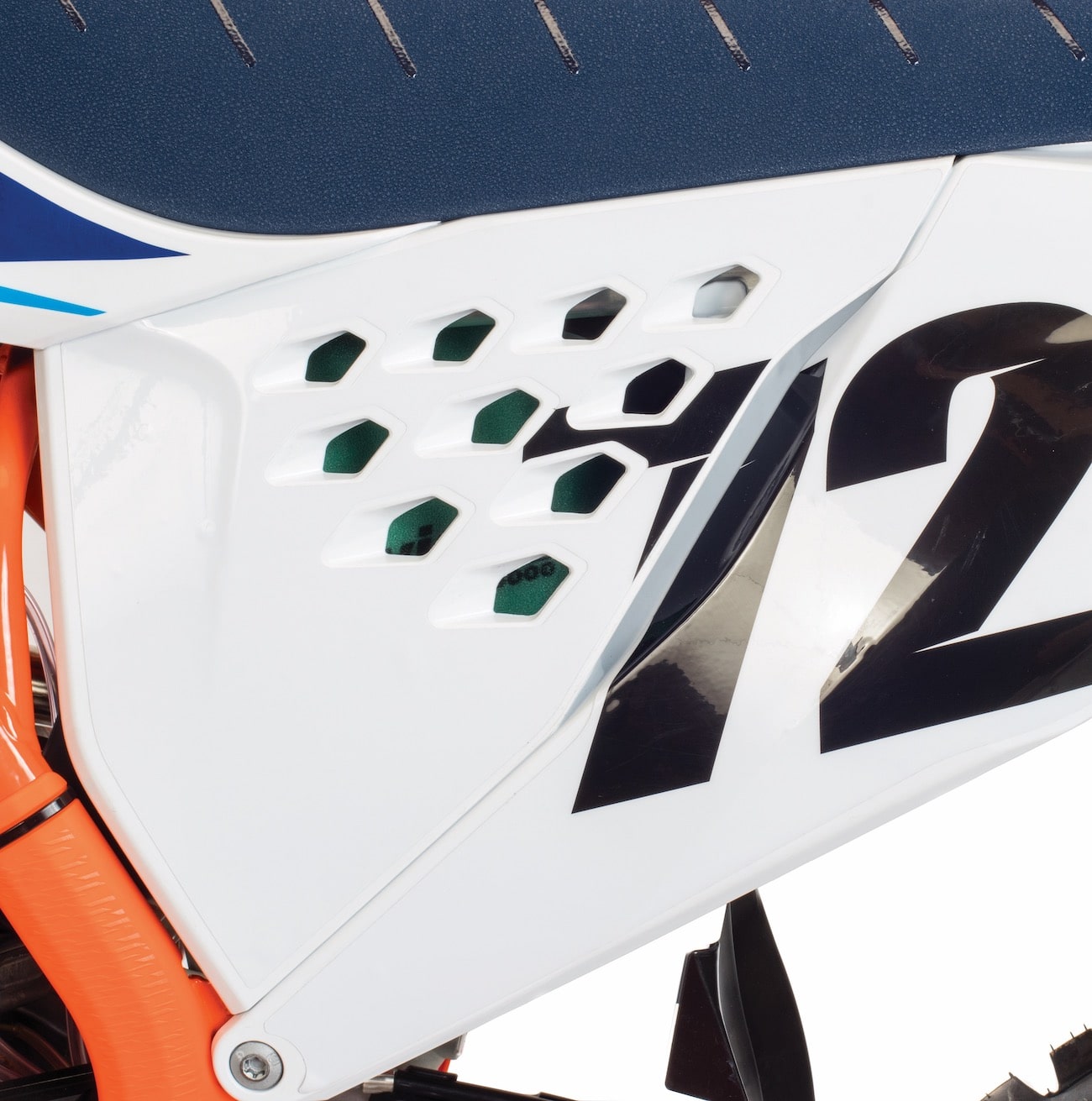
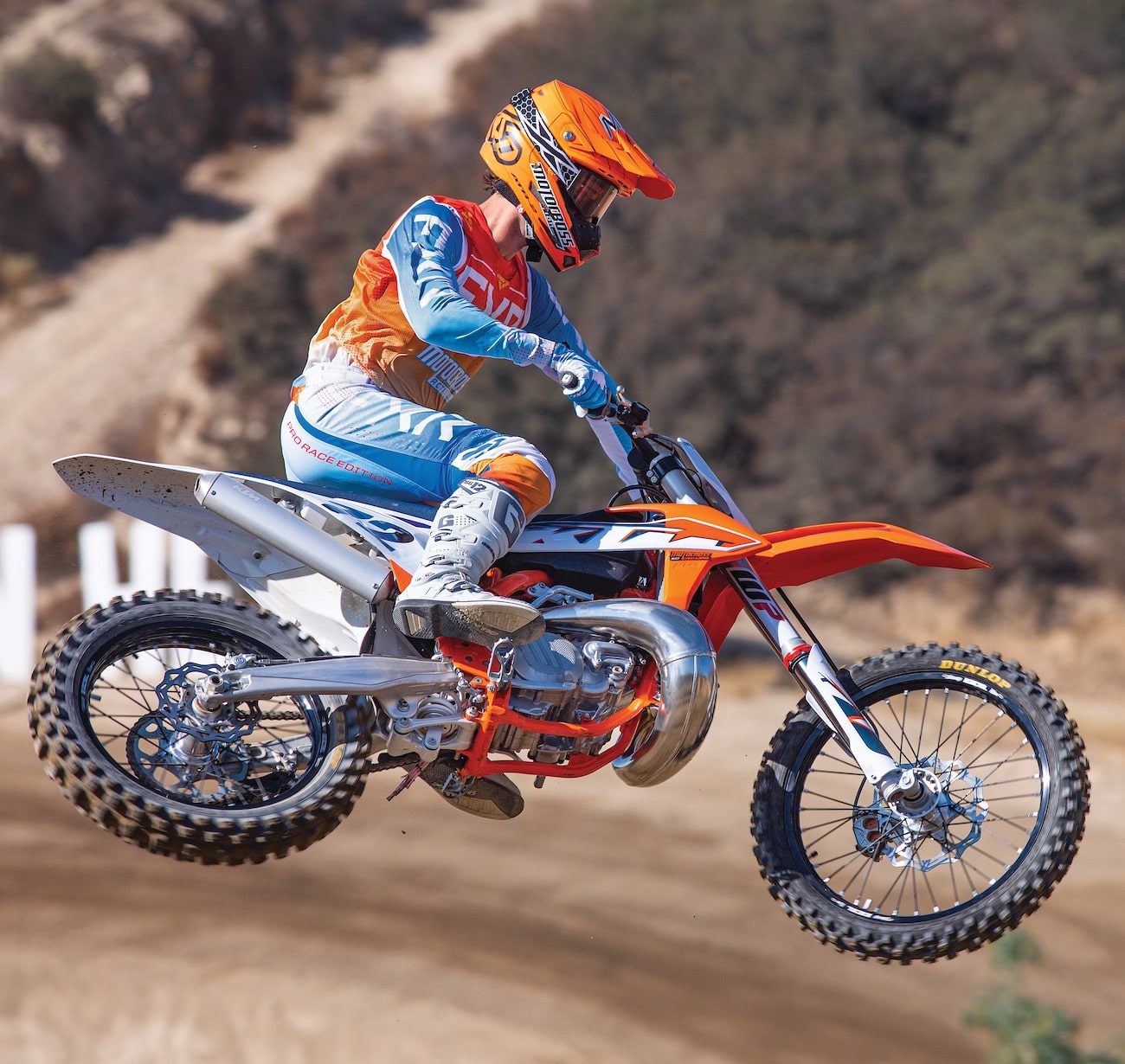

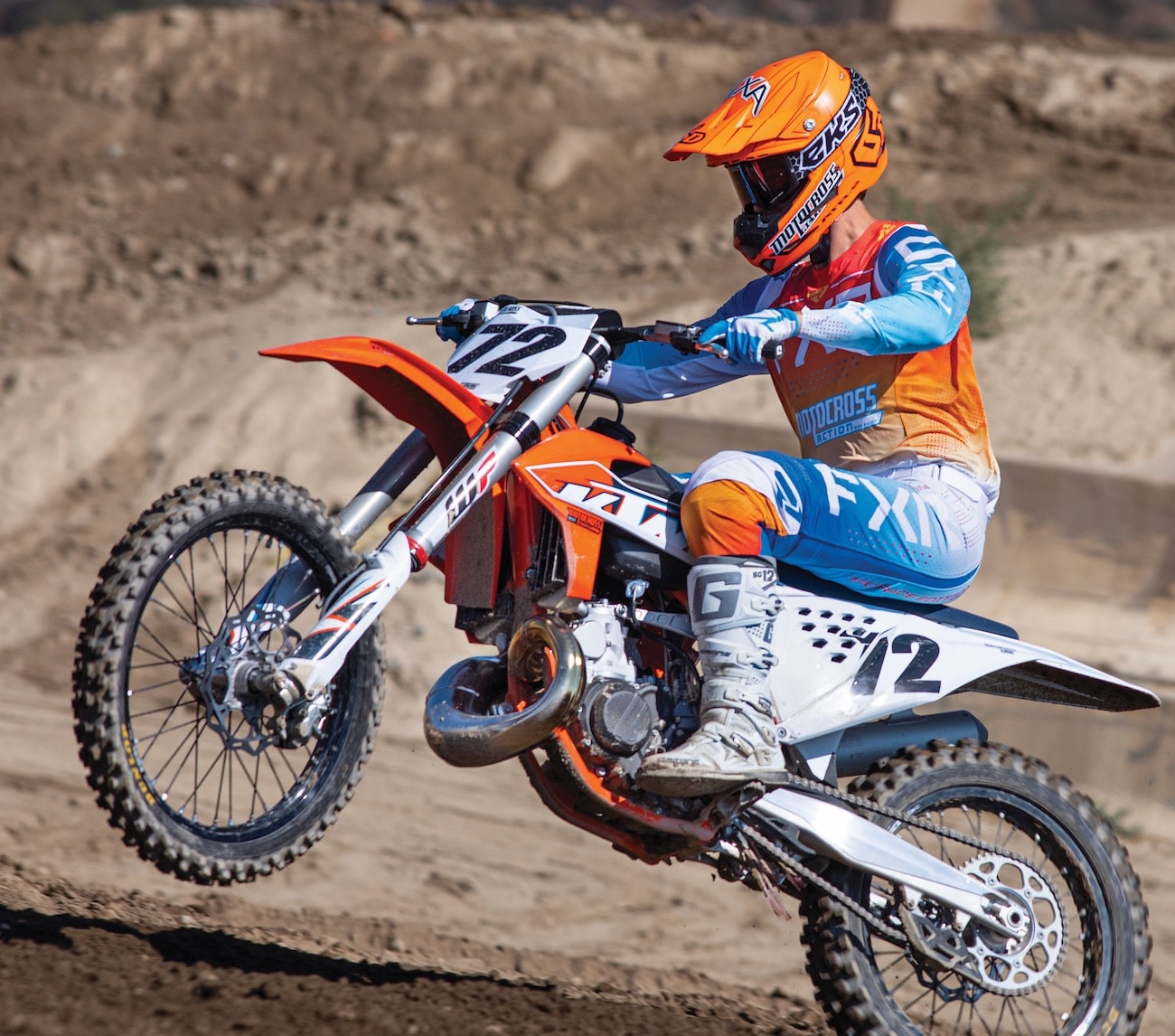

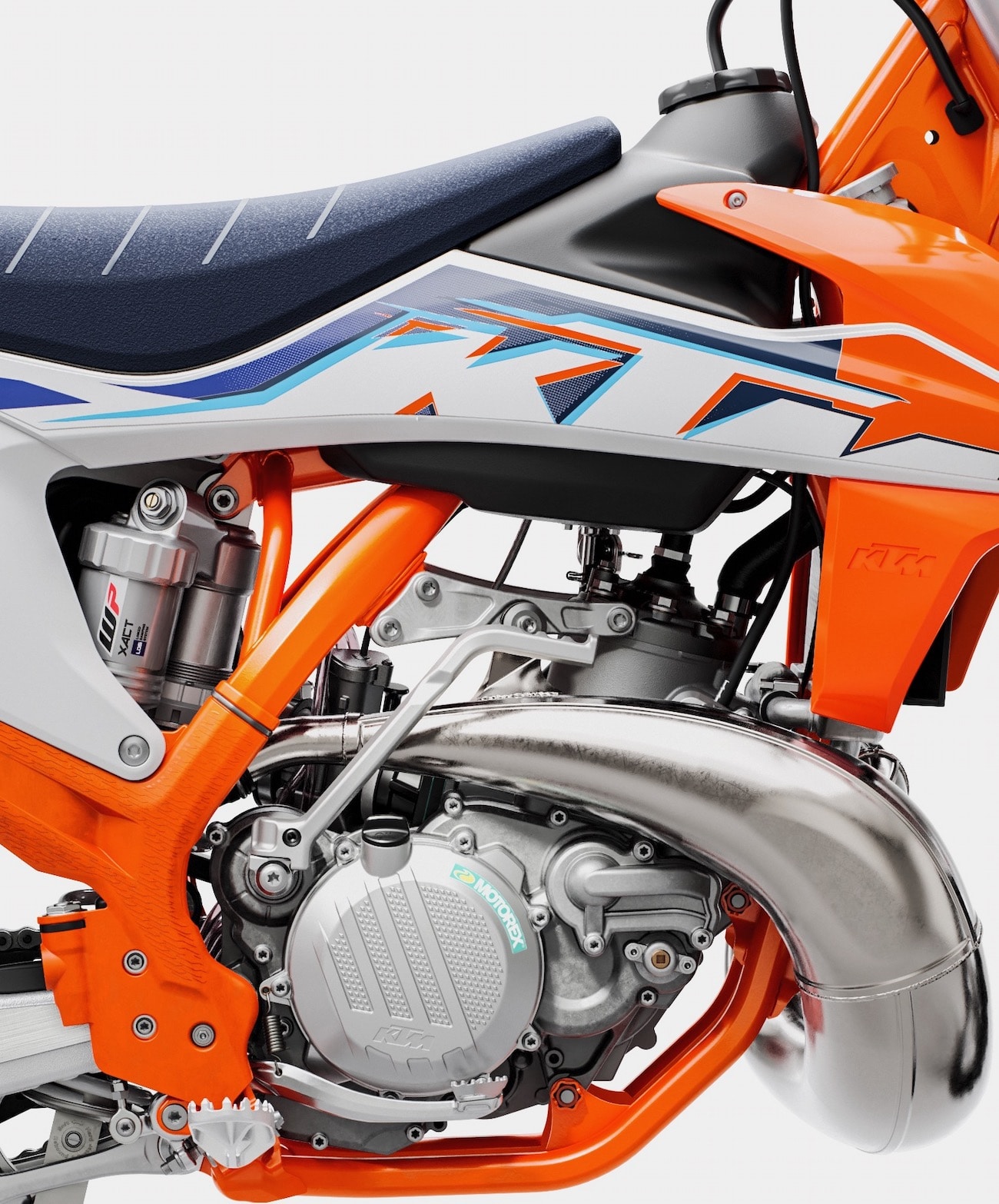



Comments are closed.